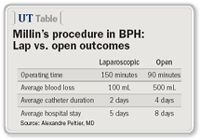Article
Lap technique may play a role in treating BPH
A laparoscopic preperitoneal approach cannot only serve as a teaching platform for laparoscopic skills for surgeons, but it also demonstrates reproducible outcomes in the treatment of BPH.

Key Points
Berlin-A laparoscopic preperitoneal approach cannot only serve as a teaching platform for laparoscopic skills for surgeons, but it also demonstrates reproducible outcomes in the treatment of BPH, according to Belgian researchers who presented their results at the European Association of Urology annual congress here.
Researchers from the Institut Jules Bordet, Universite Libre de Bruxelles in Brussels, conducted a 102-patient prospective study comparing a classical open Millin's retropubic transcapsular adenectomy in 51 patients and a laparoscopic preperitoneal approach in 52 patients according to a step-by-step transposition of Millin's procedure described in European Urology (2004; 45:103-9).
Preoperative characteristics were comparable between the groups with respect to age, prostate volume measured by trans-rectal ultrasonography, preoperative micturition, post-void residual volume, and International Prostate Symptom Score (IPSS).

More pronounced was the difference between the two techniques in blood loss: A 500-mL loss on average was recorded in patients who received the open Millin's procedure compared to an average 100-mL loss in those who underwent the lap-aroscopic Millin's approach. Dr. Peltier noted that this difference also is seen in other laparoscopic procedures, as hemostasis can be better achieved with pneumoperitoneum gas pressure and magnification of the view. The groups also had comparable functional results, including normalized residual and maximum urinary flow rate values.
"What is surprising from our results is the symptomatic issue, with an outcome in favor of the laparoscopic technique, showing an IPSS of 6 in the open technique and an IPSS of 3 in the laparoscopic," Dr. Peltier said. "This statistically significant result is somewhat difficult to explain. Perhaps it is because the procedure is more accurate or more complete."
Lap advantage

"This is logical and even foreseeable because, in the laparoscopic technique, there are less incisions, less trauma, and this subsequently decreases the chance of infection. The less invasive nature of the laparoscopic technique also leads to less pain and quicker recovery, faster mobilization, less catheter-in time and, therefore, also less chance of infection," Dr. Peltier explained.
According to Dr. Peltier, better symptomatic and functional outcomes are achieved with the laparoscopic Millin's compared to the open Millin's technique because blood loss is drastically reduced with this surgical method, and infection/morbidity and hospital stay decrease significantly, as well. However, operating time is increased in the laparoscopic method, but this increase is probably directly related to the specific learning curve for this approach, he said.
"As open prostatectomy accounts for about one-third of total invasive procedures for BPH in Europe, laparoscopy may not only provide teaching facilities for laparoscopic skills without oncological consideration and less risks for functional continence and sexual outcome, but also offers a validated option to treat BPH," Dr. Peltier said.
Learning curve
Peter J. Gilling, MD, a urologist in the ProMed Urology group in Tauranga, New Zealand, raised a question about the learning curve for the laparoscopic procedure.





